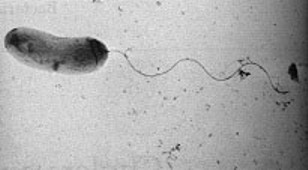Vibrio cholerae
Articles that lack this notice, including many Eduzendium ones, welcome your collaboration! |
Classification
Higher order taxa
Domain: Eubacteria
Phylum: Proteobacteria
Class: Gamma Proteobacteria
Order: Vibrionales
Family: Vibrionaceae
Species
Genus: Vibrio
Species: V. cholerae
Description and significance
Vibrio Cholerae is a gram negative, curved rod-shaped bacterium that has a single polar flagellum. It is an aerobic organism and thrives best in alkaline mediums. The bacteria are most often found in aquatic environments such as marine habitats, water courses, wetlands, and lakes.
Genome structure
Describe the size and content of the genome. How many chromosomes? Circular or linear? Other interesting features? What is known about its sequence? Does it have any plasmids? Are they important to the organism's lifestyle?
Cell structure and metabolism
Describe any interesting features and/or cell structures; how it gains energy; what important molecules it produces.
Ecology
Describe any interactions with other organisms (included eukaryotes), contributions to the environment, effect on environment, etc.
Pathology
Vibrio cholerae is the causative agent of a serious epidemic disease Cholera. Cholera is a harmful bacterial ailment that often causes severe diarrhea which is usually procurred by drinking contaminated water. When ingested, Vibrio cholerae adapts itself to colonize in the human intestinal tract, mainly the small intestine. It then attaches to the mucosal surface which the Vibrio cholerae would produce an extoxin, the cholera toxin. The cholera toxin would then act on the intestinal mucosal cells by altering the ion transport pumps that control ion fluxes. Since water freely passes through membranes, the only way to control the movement of water into and out of tissue is to control the concentration of ions in the body. The cholera toxin diminishes the net flow of sodium into the tissue and generates a net flow of chloride and water out of the tissue and into the lumen. This causes an electrolyte imbalance in the system which in consequence, bring about copious amounts of diarrhea.
Application to Biotechnology
Does this organism produce any useful compounds or enzymes? What are they and how are they used?
Current Research
Enter summaries of the most recent research here--at least three required
